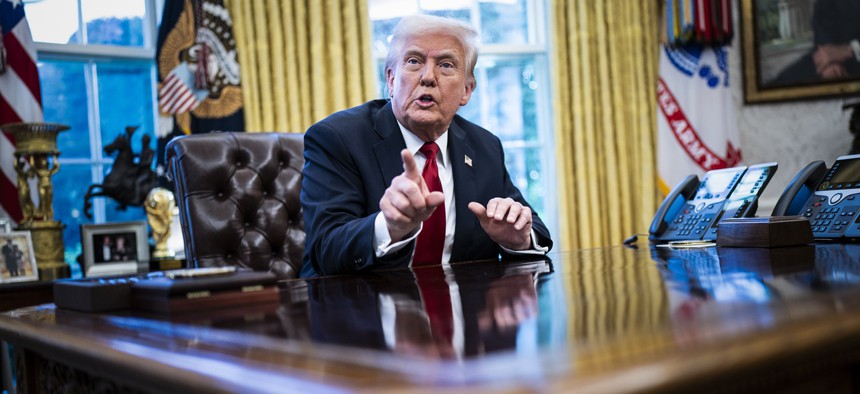Trump calls on OSTP to ‘blaze a trail’ in global tech dominance and R&D

President Donald J Trump speaks to reporters about auto tariffs after signing an executive order in the Oval Office at the White House on Wednesday, March 26, 2025 in Washington, DC. Trump penned a letter to the OSTP director that day calling for him to lead the government to global tech dominance. Jabin Botsford/The Washington Post via Getty Images
President Trump told Office of Science and Technology Policy Director Kratsios that the office’s mission will be to both compete with foreign adversaries and use technology to improve American life.
Maintaining a competitive advantage in emerging technology fields will be among the primary goals for the 2025 White House Office of Science and Technology Policy, as outlined in a letter President Donald Trump sent to newly-confirmed OSTP Director Micheal Kratsios on Wednesday.
Trump outlined three key challenges for the office to address: how the U.S. can secure its position as the “unrivaled world leader” in critical and emerging technology; how the U.S. science and tech enterprise can be further enabled to achieve breakthrough discoveries and innovations; and how U.S. scientific discoveries can be leveraged to benefit all Americans.
He further drew a contrast between what his administration’s plans are versus how the previous Biden administration’s OSTP navigated emerging tech policy. Trump cited his signing of the initial National Quantum Initiative Act in 2019 as an action that spurred U.S. quantum information sciences’ research and development, and the creation of the U.S. Space Force as an effort that continues to push frontiers in space exploration.
“After 4 long years of weakness and complacency, we must set our sights even higher,” the letter reads. “I am calling upon you to blaze a trail to the next frontiers of science. We have the opportunity to cement America’s global technological leadership and usher in the Golden Age of American Innovation.”
The letter calls for new paradigms in the U.S. research enterprise, specifically new funding models for scientific R&D.
“We must build an ecosystem that attracts top talent, celebrates merit, protects our intellectual edge, and enables scientists to focus on meaningful work rather than administrative box checking,” the letter says.
Advocacy groups were receptive to the importance the letter placed emerging technical fields. BSA Software Alliance Senior Vice President of Global Policy Aaron Cooper said that his group welcomes actions the administration takes to reduce barriers to AI system innovation and adoption.
“By leading globally, promoting AI R&D, and setting clear and consistent expectations for companies that develop AI so it can be used with confidence, the administration can make sure all industries and consumers in America benefit from AI,” Cooper said in comments to Nextgov/FCW.
Trump’s letter comes amid mass uncertainty among federal workers surrounding their futures. February saw the mass terminations of probationary employees across the government ordered by the Trump administration, which included some personnel working at the frontlines of AI and scientific research and policy.
Lawmakers have raised concerns about the impacts of those firings over the weeks. In a letter dated March 19, lawmakers on the House Committee on Science, Space and Technology wrote to Commerce Secretary Howard Lutnick asking for more information surrounding the “irrational and senseless firings” of probationary employees at the National Oceanic and Atmospheric Administration’s Office of Space Commerce.
“If OSC is gutted, the harm to America’s economy, its national security, and its public safety will leave everyone worse off,” the letter reads.






